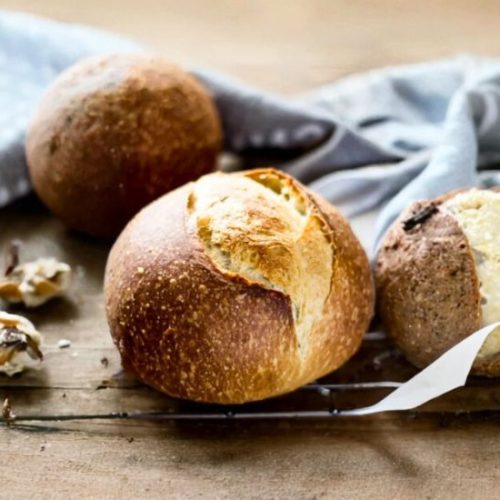
Sourdough Bread
This rustic sourdough bread is a perfect introduction to artisan baking at home. Made with just five pantry-friendly ingredients—bread flour, active starter, water, sea salt, and a touch of olive oil—this recipe yields a crusty, golden loaf with a soft, airy interior. The olive oil enriches the dough, offering a delicate flavor and a beautifully tender crumb. With guided steps and flexible fermentation, it’s beginner-friendly yet satisfying for seasoned bakers. Ideal for sandwiches, toast, or as a comforting side, this bread is both nourishing and naturally vegan.
Equipment
- 1 Digital Kitchen Scale – for accurate flour, water, and starter measurement
- 1 Large Mixing Bowl – to mix and ferment the dough
- 1 Bench Scraper – for shaping and handling dough
- 1 5.5–6 Quart Dutch Oven – for baking and steam retention
- 1 Proofing Basket or Cloth-Lined Bowl – optional, for structured second rise
- 1 Bread Lame or Serrated Knife – for scoring the dough
Ingredients
- 150 g 5.35 oz active sourdough starter
- 250 –325 g 8.8–11.5 oz warm filtered water (start with 250 g for firmer dough)
- 25 g 0.9 oz olive oil
- 500 g 17.65 oz bread flour (not all-purpose)
- 10 g 0.4 oz fine sea salt
- Fine cornmeal or parchment paper for dusting or lining
Instructions
- Mix the Dough: In a large mixing bowl, combine your sourdough starter, warm water, and olive oil. Stir together with a fork until blended. Add the bread flour and salt, and continue mixing until the dough thickens and becomes shaggy. Use your hands to press and squeeze the mixture together until no dry flour remains. Cover the bowl with a damp towel or plastic wrap and let it rest for 30 to 60 minutes to hydrate (a process called autolyse).
- Form a Rough Dough Ball: After resting, return to the bowl and gently shape the dough into a rough ball by folding and tucking the edges inward. This only takes about 15 seconds and helps begin the gluten development.
- Bulk Fermentation (First Rise): Cover the bowl tightly and let the dough rise in a warm spot (around 70–75°F or 21–24°C). Allow it to ferment until it looks puffy and has nearly doubled in size. This may take anywhere from 4 to 12 hours, depending on the temperature and strength of your starter.
- Optional: Strengthen with Stretch & Folds: To improve structure, you can perform 1–2 sets of stretch and folds during the first few hours of bulk fermentation. Simply lift one side of the dough, stretch it upward, and fold it over itself. Rotate and repeat on all sides to complete one set. Wait about an hour between sets.
- Shape the Dough: Turn the dough out onto a lightly floured surface. Avoid punching it down—gently handle it to preserve gas bubbles. If making two loaves, divide it now. To shape, fold the dough in sections toward the center until you form a round. Flip it seam-side down and use your hands to gently tighten the shape into a smooth ball.
- Second Rise (Proofing): Place the shaped dough into a Dutch oven lined with parchment or dusted with cornmeal. Alternatively, use a floured proofing basket. Let it rest for 30 minutes to 1 hour, covered, until slightly puffed but not doubled in size. Meanwhile, preheat your oven to 450°F (232°C).
- Score the Dough: Use a bread lame or sharp knife to make a shallow 2–3 inch slash across the top of the dough. This allows controlled expansion during baking.
- Bake the Bread: Place the Dutch oven into the hot oven, reduce the heat to 400°F (204°C), and bake with the lid on for 20 minutes. Remove the lid and continue baking for 35–40 minutes, or until the crust is deep golden brown and the loaf sounds hollow when tapped.For accuracy, the internal temperature should reach 205–210°F (96–98°C).
- Cool Before Slicing: Transfer the bread to a wire rack and let it cool for at least 1 hour before slicing. Cutting too soon may result in a gummy texture.
Notes
- Hydration Adjustment: For a more elastic, airy dough, increase water to 300–325 g. Higher hydration doughs should be proofed in a banneton to retain shape.
- Best Practice: Always weigh ingredients with a digital scale for consistent results—cups are not accurate for bread baking.
- Storage Tip: Store the loaf at room temperature in a paper bag or wrapped in a tea towel. Avoid plastic, which softens the crust.
- Flour Brands Tested: King Arthur Bread Flour, Gold Medal Bread Flour, and Pillsbury Bread Flour work reliably.
- Sourdough Timing: Rise times will vary greatly based on your room temperature and the activity of your starter. Always rely on visual cues rather than the clock.